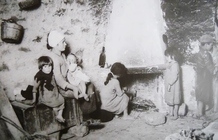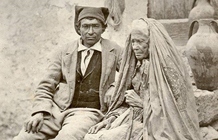Women clothes
Young ladies use to wear a particular linen skirt underneath the petticoat, sometimes made of cotton or wool too, often colored and called “fodetta” or “fadedda” in Sicilian. It is a simple comfortable and clean garment that is wore from the waist down to the feet often kept together and tied at the breasts with the “spensiru” (a simple white or colored tissue) back from the shoulders.
On the head is usually wore a bone or silver brooch or a simple ribbon eventually. A turtle comb was used sometimes to distinguish from the middle-low classes and to hold and comb hair together. Earrings are made of gold, coral fragments, a gold necklace or a silver heart to appeal the neck. Socks are normally sky-blue colored and shoes are black.
Women used to wear a thin black cloak lined in red or pink to adorn the face, which was used to cover the head and the breasts down to the belt. Clothes were simple and humble. They used to wear always that cloak regardless of the time and season outside their houses, to work included.
In case of religious or uncommon events, they used to wear the “fadigghia” on top of their colored clothes. The “fadigghia” was a silk garment usually wore from the belt to the feet along with a cloak from the head to the knees. This cloak is perhaps the most iconic garment of the entire Sicilian culture, used to protect the discretion and modesty of the women. It is not used in the big cities but found sometimes inlands. The German Westphals discovered it in Palermo in 1818. Malagoli-Vecchj found it decades later in Catania too in those who did not want to be part of the common people.
Houel used to complain with women from Messina about the thickness of this cloak, keeping their beauty hidden from other people eyes. In reality the cloak was used wisely by the Sicilian women of that time to direct and convey their attention to the designated man they wanted to seduce as they were opening half of it to let man to catch sight of their skin of face and immediately closing it again. This behavior was used to seduce the man as he was granted to see a prohibited glimpse of their womanliness. The face, the breasts, the pale skin, everything was acted with grace and in a glimpse of time. All woman, married and single, used that cloak.
In Catania, it has been replaced by the “scialle”, a thicker cloack but smaller, black and not pinned. A woman with her clock and her skirt is considered to own something nowadays as per the motto:
Whoever wears the cloak and the skirt is not poor





